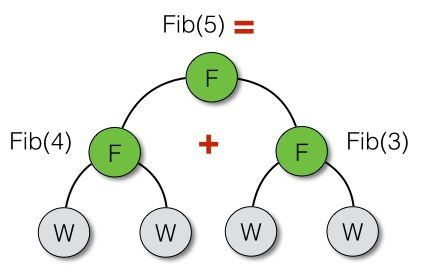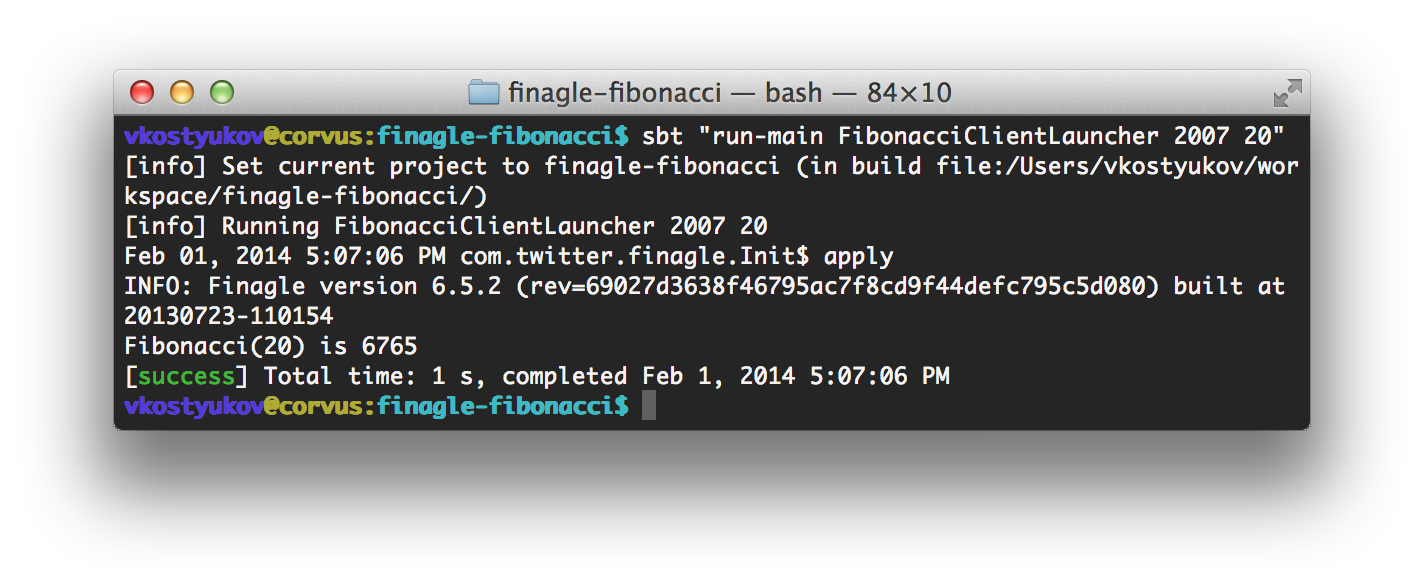Finagle Your Fibonacci Calculation
Finagle is an RPC library for JVM that allows you to develop service-based applications in a protocol-agnostic way. Formally, the Finagle library provides both asynchronous runtime via futures and protocol-independence via codecs. In this post I will try to build a Finagle-powered distributed Fibonacci Numbers calculator that scales up to thousands of nodes.
Topology Design
Lets start with the requirements. At the first glance, we might want to see our system both fault-tolerant and scalable. These are typical requirements for any kind of distributed system. And the good news here, Finagle provides a corresponding set of building blocks and mechanisms (such as load balancing, retrying, monitoring, etc.) that allows the developer easily write a reusable scalable and fault-tolerant code without a particulate knowledge about concrete protocols.
Anyway, such things like scalability should be done at some different level then framework or library level. The systems should be scalable by design not by any fancy tool. Thus, we must remember it at any stage of application life-cycle.
In order to design the scalable system we have to understand the problem we’re trying to solve. The classic Fibonacci calculation algorithm builds a recursive tree with height O(n) and branching factor 2. Thus, the most natural and suitable service topology we can use here is a hierarchical one. The hierarchical or tree-based topology satisfy both scalability and fault-tolerance requirements. So, the distributed Fibonacci calculator might be viewed as following

In other words, we simply maps every node from the recursive tree (the algorithm’s abstraction) to physical/distributed nodes. The proposed topology tree has two kind of nodes - leaf nodes with label W (workers) and branch nodes with label F (fanouts). The worker node is our workhorse that does all the magic, while the fanout node doesn’t really perform calculation but implements map-reduce approach by delegating the sub-problems to child nodes. The number of nodes in such tree is unlimited, but doesn’t really make sense having workers more than a number of logical cores in your CPU. For example, a suitable configuration for a typical Haswell laptop with four logical cores looks exactly like the picture above.
Finagle Power
The Finagle’s API provides three robust building blocks: futures, filters and services. All the building blocks are designed to be composable in a very neat way. Thus, keeping in mind that futures are single-element immutable containers while services and filters are just functions, it’s really simple to reason about Finagle-powered code.
Finagle is a service-oriented platform. So, all the interactions between servers and clients are built around services. Servers implements their behavior via services, while clients interacts with servers via services. Finally, service is just a function that takes type A and returns a future of type B.
trait Service[A, B] {
def apply(a: A): Future[B]
}The Future type represents a placeholder for a response being sent from server. Programming with futures is an asynchronous programming discipline that relies on transforming values rather than reasoning about sequence of events and callbacks.
The last but not least thing to discuss - Finagle’s filters, which are actually decorators for services. Filters allow to change the behavior of services at running time as well as to change their types and get some benefits from Scala’s type checker at compile time.
Abstractions
Lets start with a cornerstone abstraction - a Fibonacci calculator that takes a BigInt number of Fibonacci member and returns a future of its value. It also a good idea to predefine a useful BigInt values in the same trait.
trait FibonacciCalculator {
val Zero = BigInt(0)
val One = BigInt(1)
val Two = BigInt(2)
def calculate(n: BigInt): Future[BigInt]
}Now we can define a worker node implementation that uses a for comprehension for future pipelining (sequential composition). The straightforward implementation looks exactly like the classic recursive algorithm.
object LocalFibonacciCalculator extends FibonacciCalculator {
def calculate(n: BigInt): Future[BigInt] =
if (n.equals(Zero) || n.equals(One)) Future.value(n)
else for { a <- calculate(n - One)
b <- calculate(n - Two) } yield (a + b)
}Thus, the fanout node implementation might be defined as following
class FanoutFibonacciCalculator(
left: FibonacciCalculator,
right: FibonacciCalculator) extends FibonacciCalculator {
def calculate(n: BigInt): Future[BigInt] =
if (n.equals(Zero) || n.equals(One)) Future.value(n)
else {
val seq = Seq(left.calculate(n - One), right.calculate(n - Two))
Future.collect(seq) map { _.sum }
}
}The fanout calculator uses a concurrent compositor Future.collect() (which takes the sequence of futures and returns the future of sequences) in order to process left and right sub-trees in parallel. The last future transformation that is performed by fanout calculator is summing up the sequence.
In our system, we will use the String-based transport layer provided by Finagle’s example of Echo Server, which means we need to provide a suitable adapter implementation that adapts the String-based service Service[String, String] to FibonacciCalculator interface. This will allow us to use remote workers as fanout node’s children.
class RemoteFibonacciCalculator(remote: Service[String, String])
extends FibonacciCalculator {
def calculate(n: BigInt): Future[BigInt] =
remote(n.toString) map { BigInt(_) }
}Good news here is that BigInt can be converted to the String (and vice versa) out-of-the box, so we can easily perform the conversion in one line.
Now we’re ready to setup our service that takes a Fibonacci calculator and delegates the clients’ requests to it. Also, a bit of type conversions should be done here. The FibonacciService can be treated as an adapter of FibonacciCalculator to Service interface.
class FibonacciService(calculator: FibonacciCalculator)
extends Service[String, String] {
def apply(req: String): Future[String] =
calculator.calculate(BigInt(req)) map { _.toString }
}Server and Client Configurations
Finally, we can define a server that handles our Fibonacci service. The launcher should allow the user to run either the worker node or fanout node by specifying the corresponding command line options. The complete implementation looks like following.
object FibonacciServerLauncher {
def main(args: Array[String]): Unit = main(args.toSeq)
def main(args: Seq[String]): Unit = args match {
case Seq("leaf", port) =>
val service = new FibonacciService(LocalFibonacciCalculator)
Await.ready(FibonacciServer.serve(":" + port, service))
case Seq("node", port, left, right) =>
// remote services
val ls = FibonacciClient.newService("localhost:" + left)
val rs = FibonacciClient.newService("localhost:" + right)
// remote calculators
val lc = new RemoteFibonacciCalculator(ls)
val rc = new RemoteFibonacciCalculator(rs)
// a fanout
val service = new FibonacciService(new FanoutFibonacciCalculator(lc, rc))
Await.ready(FibonacciServer.serve(":" + port, service))
}
}The client launcher looks much simpler though.
object FibonacciClientLauncher {
def main(args: Array[String]): Unit = main(args.toSeq)
def main(args: Seq[String]): Unit = args match {
case Seq(port, req) =>
val client = FibonacciClient.newService("localhost:" + port)
val rep = Await.result(client(req))
printf("Fibonacci(%s) is %s\n", req, rep)
case _ => println("Bad arguments!")
}
}The complete source code of both client and server is available at GitHub.
Now, it’s time to build the topology from the first picture (the binary three with seven nodes). The following script builds the tree in a bottom-up manner by launching a seven instances on the same machine.
$ sbt "run-main FibonacciServerLauncher leaf 2001" && \
sbt "run-main FibonacciServerLauncher leaf 2002" && \
sbt "run-main FibonacciServerLauncher node 2003 2002 2001" && \
sbt "run-main FibonacciServerLauncher leaf 2004" && \
sbt "run-main FibonacciServerLauncher leaf 2005" && \
sbt "run-main FibonacciServerLauncher node 2006 2005 2004" && \
sbt "run-main FibonacciServerLauncher node 2007 2006 2003"From the client-side, system usage looks pretty simple. The client should interact with a root node of the topology tree. In our case, with an instance on port 2007.

Filters as Services’ Decorators
Filters provide a natural and clean way of changing the services’ behavior by chaining their requests through the number of nested filters. Thus, the same protocol-independent filters can be used at both server and client sides.
Lets consider the example of the filter that simply logs services’ requests to the console.
object LogStringFilter extends Filter[String, String, String, String] {
def apply(req: String, srv: Service[String, String]): Future[String] = {
println("Got a request: " + req)
srv(req)
}
}The filter can be applied to the service by andThen operator. In order to make workers dump their requests we can change the launcher configuration as following.
val service = new FibonacciService(LocalFibonacciCalculator)
Await.ready(FibonacciServer.serve(":" + port, LogStringFilter andThen service))Is it Scalable and Fault-Tolerant?
The suggested tree-based topology might be scaled in a bottom-up manner by adding new levels of fanout nodes. But, it’s not that easy to configure the system with only shell commands described before. Any kind of specialized tools (like ZooKeeper, which is supported by Finagle) should be used instead.
In order to make the system fault-tolerant, we can use Finagle’s built-in load balancers as well as customized filters that implement retries and timeouts.
For example, the following client service will be balancing its requests between two nodes localhost:2001 and localhost:2002:
val client = FibonacciClient.newService("localhost:2001,localhost:2002")Further Improvements
It might be a good idea to replace the String-based transport layer with BigInt-based one. The suitable example of corresponding pipeline configurations with BigInt decoders and encoders can be found at Netty’s example directory.


